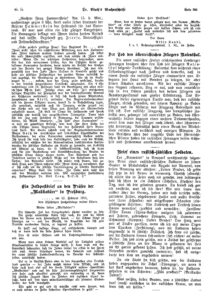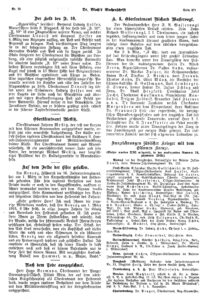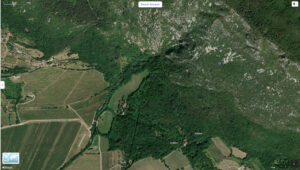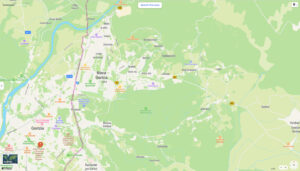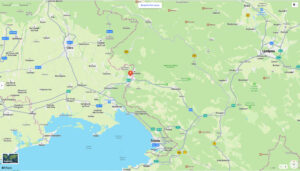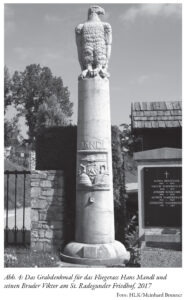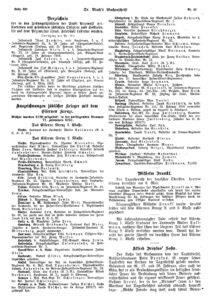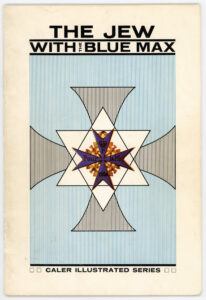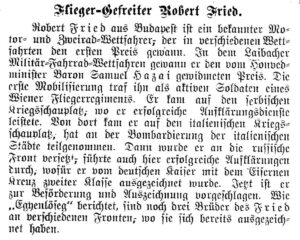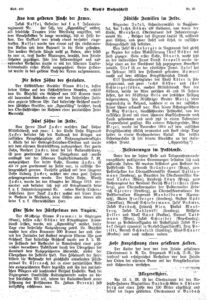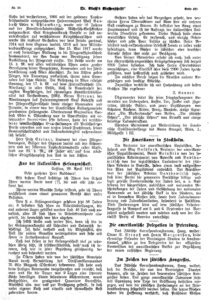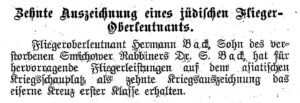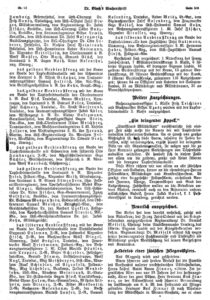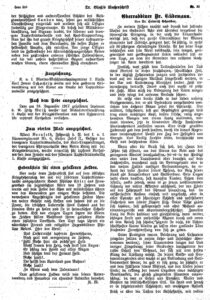The ten articles below comprise all those published by Dr. Bloch’s Oesterreichische Wochenschrift pertaining to the service of Jewish Aviators in the K.u.K. Luftfahrtruppen (Kaiserliche und Königliche Luftfahrtruppen) [Austro-Hungarian Aviation Troops / Imperial and Royal Aviation Troops ], and, the Deutsche Luftstreitkräfte [German Air Force].
Two of the articles pertain to Wilhelm Frankl, one of which reveals that the German Jewish aviator had a younger brother living in Vienna. To these I’ve included some images from Heinz Nowarra’s 1967 biography of Frankl, The Jew With the Blue Max. (I picked up Nowarra’s book at the Smithsonian some years ago.)
Though there exist compilations of aerial victories and losses for the World War One air arms of the Allies (specifically covering the British Commonwealth, France, and the United States) and Germany (albeit solely comprising aviators’ names, not information about their aircraft), I don’t know if any such works have ever been compiled pertaining to the K.u.K. Luftfahrtruppen.
The articles appear in the same format as my other posts about the Wochenschrift: The English-language translation first, followed by a verbatim transcript of the article in German (in blue), then an image of the article as it appeared in the newspaper, concluding with an image of the entire page in which the news item appeared.
______________________________
_______________
______________________________
Year 1915
The Death of the Austrian Aviator Rosenthal
April 2, 1915
Issue Number 14, Page 3
The Lemberg newspapers, which appeared under Russian censorship, reported the death of the aviator Rosenthal as follows: Rosenthal came to Zolkiew during a reconnaissance flight and noticed that a Russian aviator was billeted in a house. He began bombing the house, but did no damage. When the Russian aviator recognized the enemy, he took off, and now a bitter duel with guns developed between the two aviators in the air. The result of this peculiar duel was that the Russian pilot, fatally wounded, fell to the ground with his aircraft and in the crash dragged Rosenthal’s plane with him. The Russian plane, which was of French manufacture, landed almost unharmed, while the Austrian plane was a veritable heap of rubble, from which the plane was pulled out, still alive but badly injured. Rosenthal suffered a fracture of the spine and passed away after a few minutes. Reporting on the Austrian pilot’s tragic end, Russian newspapers praised his boldness and heroism.
Der Tod des österreichischen Fliegers Rosenthal
Die unter russischer Zensur erscheinenden Lemberger Zeitungen brachten über den Tod des Fliegers Rosenthal folgende Darstellung: Rosenthal kam während eines Erkundungsfluges nach Zolkiew und bemerkte, dass in einem Hause ein russischer Flieger einquartiert war. Er begann das Haus mit Bomben zu belegen, die aber keinen Schaden anrichteten. Als der russiche Flieger den Gegner erkannte, stieg er auf, und nun entwickelte sich in den Lüften zwischen den beiden Fliegern ein Revolverzweikampf von grosser Erbitterung. Das Ergebnis dieses eigenartigen Duells war, dass der russiche Flieger, tötlich getroffen, mit seinem Apparat zu Boden stürzte und im Absturze das Flugzug Rosenthals mit sich riss. Das russiche Flugzeug, das französisches Fabrikat war, gelangte fast unversehrt zu Boden, das österreichische bildete dagegen einen wahren Trümmerhaufen, unter dem man den Flieger noch lebend, aber schwerverletzt hervorzog. Rosenthal hatte einen Bruch der Wirbelsäule erlitten und verschied nach wenigen Minuten. In den Berichten über das tragische Ende des österreichischen Piloten hoben die russischen Zeitungen dessen Kühnheit und Heldenmut anerkennend hervor.
______________________________
_______________
______________________________
The Hero of F-10
April 9, 1915
Issue Number 15, Page 5
“Egyenlösseg” reports: Corporal Ludwig Helfer, motor driver at Z. Flugpark, is the hero of the “F. 10”. “F 10” is an army flying machine on which Oberleutnant Osvath flew up from Rszeczow with Corporal Helfer on March 4 to bring mail and orders to Przemysl. After four hours of flight, they arrived at the besieged fortress. The lieutenant took orders and mail and they flew back. In Skala, the first lieutenant was directing the plane to land when a Russian patrol suddenly appeared and saw the “F. 10” under fire. The two pilots defended themselves with their pistols, but a bullet hit the gasoline reservoir 10 meters up and the machine exploded and crashed to the ground. An Austro-Hungarian patrol, which had meanwhile arrived, drove out the Cossacks and hurried to help the inmates of the flying machine. Lieutenant Osvath lay lifeless under the rubble. Ludwig Helfer, with four bullets in his body, was still fully conscious and with the last effort handed over the post and command of our patrol. After that he lost consciousness. In the Jaroslau hospital, where he has been cared for ever since, he received the second class silver medal for bravery.
Der Held des F. 10
“Egyenlösseg” berichtet: Korporal Ludwig Helfer, Motorführer beim Z. Flugpark, ist der Held des “F. 10”. “F 10” ist eine Flugmaschine unserer Armee, auf welcher Oberleutnant Osvath mit Korporal Helfer am 4 März von Rszeczow aufflog, um Post und Befehle nach Przemysl zu bringen. Nach vierstündigem Flug langten sie in der belagerten Festung an. Der Oberleutnant übernahm Befehle und Post und sie flogen zurück. In Skala dirigierte der Oberleutant die Maschine zur Landung, als eine plötzlich aufgetauchte russische Patrouille die abwärts sausende “F. 10” unter Feuer nahm. Die beiden Piloten verteidigten sich mit ihren Pistolen, eine Kugel traf jedoch in 10 Meter Höhe das Benzinreservoir und die Maschine explodierte und stürzte zu Boden. Eine inzwischen eingetroffene österreichisch-ungarisch Patrouille vertrieb die Kosaken und eilte den Insassen der Flugmaschine zu Hilfe. Oberleutnant Osvath lag leblos unter den Trümmern. Ludwig Helfer war mit vier Kugeln im Leibe noch bie Bewusztsein ünd übergab mit letzter Kraftanstrengung Post und Befehl unserer Patrouille. Hierauf verlor er das Bewusztsein. Im Jaroslauer Spitale, wo er seitdem gepflegt wird, erhielt er die silberne Tapferkeitsmedaille zweiter Klasse.
______________________________
_______________
______________________________
Year 1916
Field Pilot Lieutenant Mandl
April 7, 1916
Issue Number 15, Page 5
The “Fremdenblatt” (March 30, 1916) is asked by a higher active officer to publish the following obituary for Field Pilot Lieutenant Hans Mandl, who died in Görz: “The relentless Grim Reaper has demanded a new, noble sacrifice. The name Hans Mandl has a good reputation far beyond the borders of our homeland, as this young human life was full of duty and heroism. The achievements that he accomplished for the emperor and the empire are marked with golden pencils in the history of the fifth weapon, which played such a prominent role in the world war. Hans Mandl! All those whom knew, valued, and loved you are shaken, the only thing left to us is the memory of your amiable personality, but we will faithfully preserve it. Countless friends mourn at your grave; the air fleet, who lost one of their noblest; the whole fatherland, which you so dearly loved and so ardently defended!”
Feldpilot Oberleutnant Mandl
Von einem höheren aktiven Offizier wird das “Fremdenblatt” (30. Marz 1916) um Veröffentlichung folgenden Nachrufes für den bei Görz gefallenen Feldpiloten Oberleutnant Hans Mandl gebeten: “Der unerbittliche Sensenmann hat ein neues, edles Opfer gefordert. Weit über die Gaue unserer Heimat hinaus hat der Name Hans Mandl einen guten Klang, war doch dieses junge Menschenleben vollausgefüllt von Pflichterfüllung und Heldentum. Die Leistungen, die er für Kaiser und Reich vollbrachte, sind mit goldenen Griffel in der Geschichte der am Weltkriege so hervorragend beteiligten fünfsten Waffe eingezeichnet. Hans Mandl! Alle, die wir dich kannten, schätzten und liebten, sind erschüttert, uns bleibt nur die Erinnerung an deine liebenswürdige Persönlichkeit, die aber wollen wir treulich bewahren. An deinem Grabe trauern zahllose Freunde, die Luftflotte, die einen ihrer Vornehmsten verloren, das ganze von dir so heiss geliebte und heiss verteidigte Vaterland!”
______________________________
_______________
______________________________
The following brief sketch of Lieutenant Mandl’s life and military service isn’t from Dr. Bloch’s Öesterreishische Wochenschrift, instead having been published in the 1916 edition of the German aviation journal Flugsport. I found the text and image via Oogle Books.
Aviation
Illustrated Technical Journal for the Whole of Aviation
Oskar Ursinus – Frankfurt am Main
1916
Field pilot Lieutenant Hans Mandl is killed. Field pilot Hans Mandl, first lieutenant in Fortress Artillery Regiment No. 4, died a hero’s death in a flight near Gorizia. Mandl, who was only 29 years old, was one of the best and most efficient Austrian pilots. In 1912 he was assigned to the Air Corps, passed the field pilot’s examination on February 24, 1913 and then worked as a flight instructor in Wiener-Neustadt until the outbreak of war. On August 24, 1913, Mandl, who was still a lieutenant at the time, made the flight from Wiener-Neustadt via Graz to Ljubljana. This was the second crossing of the Pemmering in an airplane and the first flight over this long distance, which Mandl flew in three and a half hours at an average speed of over a hundred kilometers. For his outstanding service in the war he was awarded the Order of the Iron Crown, third class, and recently the Signum laudis.
Flugsport
Illustriert-Technische Zeitschrift fur das Gesamte Flugwesen
von Oskar Ursinus – Frankfurt am Main
Feldpilot Oberleutnant Hans Mandl gefallen. Feldpilot Hans Mandl, Oberleutnant im Festungsartillerieregiment Nr. 4, hat bei einem Fluge in der Nahe von Görz den Heldentod gefunden. Mandl, der erst im 29. Lebensjahre stand, war einer der besten und tüchtigsten Österreichischen Flieger. Im Jahre 1912 liess er sich dem Fliegerkorps zuteilen, legte am 24. Februar 1913 die Prüfung als Feldpilot ab und war dann bis zum Ausbruch des Krieges als Fluglehrer in Wiener-Neustadt tätig. Am 24. August 1913 hatte Mandl, damals noch Leutnant, den Flug von Wiener-Neustadt über Graz nach Laibach gemacht. Es war dies die zweite Ueberquerung des Pemmerings im Flugzeug und der erste Flug über diese weite Strecke, welche Mandl in dreieinhalb Stunden mit einer Durchschnittsgeschwindigkeit von über hundert Kilometer durchflog. Für seine hervorragenden Leistungen im Kriege wurde er durch die Verleihung des Ordens der Eisernen Krone dritter Klasse und kürzlich durch die Verleihung des Signum laudis ausgezeichnet.
Here’s the cover of Flugsport’s 1916 edition…
______________________________
Lieutenant Mandl crashed to earth east of Gorizia, Italy, near the source (head) of the Lijak Stream, within present-day Slovenia, during an interregnum between the fifth and sixth Battles of the Isonzo. In this air photo, the head of the Lijak Stream appears near the very center of the image. The stream itself flows to the southwest, and can be seen – as a narrow and irregular strip of vegetation – just to the right (east) of a small airstrip in the lower left center of the image.
Zooming out, you can see the Lijak Stream’s head near the right edge of the image. The stream itself (farmland to the right and forest to the left) flows south-southwest, and is crossed by highway 444. The white line running north-northeast to west-southwest in the left side of the image is the national border between Slovenia to the east and Italy to the west. The cities of Nova Gorica and Gorizia are respectively situated on opposite sides of the border.
This map, at the same scale as the above photo, shows the geography of Gorizia and Nova Gorica.
At an even smaller scale, this map shows the border between Italy and Slovenia. The two above-mentioned cities are situated near the center of the map.
Five images of the spot where Lt. Mandl crashed, and, a plaque in his memory mounted upon on a rock wall at the site, can be viewed at Mihel Spomemnik’s August, 2005 post at Pro Hereditate 1915-1917 (“avstroogrskemu pilotu nadporočniku Hansu Mandlu” [“Austro-Hungarian pilot Lieutenant Hans Mandel”]). As described at the post, “Tekstovni opis V bližini izvira potoka Lijak stoji večja skala, na kateri je pritrjena napisna plošča, postavljena v spomim na sestreljenega avstroogrskega pilota Hansa Mandla.” (“Near the source of the stream Lijak there is a larger rock, on which is attached an inscription plaque, erected in memory of the downed Austrian pilot Hans Mandel.”)
The monument bears this inscription:
He stormed in front of the
enemies on March 30, 1916
Kaiserliche und Königliche First Lieutenant
HANS MANDL
Knight of the Iron Cross III Class
Cross of Military Merit – Old Reward Files
In 1914, 1915 and 1916
Austria’s best flyer.
———————————
Dedicated by Flying (?) 19
Original German text:
Hier stürmte vor dem
Feinde am 30. März 1916
der k. u. k. Oberlt
HANS MANDL
Ritter des E.K.III Kl.
M. V. K. A. B. A.
In den Jahren 1914,15 u. 16
Östr. bester Flieger.
——————————–
gew. von der Fliegerad. 19
As described below by Harald D. Groller in St. Radegund. A Styrian health resort and its history, Lieutenant Mandl is buried at the Sankt Radegund Cemetery. The municipality of St. Radegund (for Sankt Radegund (English: Saint Radegund)) is in the district of Braunau am Inn in the Austrian state of Upper Austria. The cemetery itself is located at Braunau am Inn, Braunau am Inn Bezirk.
“Anyone who knows the St. Radegund cemetery a little better will perhaps have noticed one of the most peculiar gravestones in the country: it is that of the brothers Dr. Viktor Mandl, judge in Fürstenfeld, who had already fallen in November 1914 in Galicia, and Lieutenant Colonel Hans Mandl, who fell in March 1916 in the southern theater of war. Both dead were sons of the St. Radegund spa director at the time.
As the gravestone makes it easy to guess, Hans Mandl was one of the flying aces of his time. In 1913 he became the second Austrian to fly over the Semmering and he was the pilot of the first Austrian long-distance flight from Vienna to Ljubljana, although this triumph was diminished by the fact that the plane burned down on the return flight. Hans Mandl was also the first Austrian pilot to fly one – and then several – loops, thereby writing sports history. In the years 1914 to 1916 the best Austrian pilot, he crashed on March 21, 1916 on the Isonzo front near Gorizia and died.”
____________________
Wer den St. Radegunder Friedhof etwas näher kennt, dem wird vielleicht schon einer der eigenartigsten Grabsteine des Landes aufgefallen sein: Es handelt sich um jenen der Brüder Dr. Viktor Mandl, Richter in Fürstenfeld, der bereits im November 1914 in Galizien gefallen war, und des Oberstleutnants Hans Mandl, gefallen im März 1916 am südlichen Kriegsschauplatz. Beide Gefallenen waren Söhne des damaligen St. Radegunder Kurdirektors.
Wie der Grabstein unschwer erahnen lässt, handelt es sich bei Hans Mandl um eines der Fliegerasse seiner Zeit. Ihm gelang es 1913 als zweitem Österreicher, den Semmering zu überfliegen, und er war der Pilot des ersten österreichischen Langstreckenfluges von Wien nach Laibach, wobei dieser Triumph dadurch geschmälert wurde, dass das Flugzeug beim Start zum Rückflug abbrannte. Hans Mandl war auch der erste österreichische Pilot, der einen – und gleich darauf mehrere – Loopings flog und damit Sportgeschichte schrieb. In den Jahren 1914 bis 1916 bester österreichischer Flieger, stürzte er am 21. März 1916 an der Isonzofront bei Görz ab und kam dabei ums Leben.
Harald Groller’s article includes a photograph of the eagle-headed monument erected at the grave of the Mandl brothers, as shown in this 2017 photo by HLK / Meinhard Brunner. The fact that Hans Mandls’ death in combat was reported upon in Dr. Bloch’s Öesterreishische Wochenschrift, yet he and his brother were buried in a Christian cemetery, suggests that the though the family were Jews, by the advent of the First World War the family’s ties to or affiliation with the Jewish community – whether in terms of religion, history, community, kinship, or simple feeling – had attenuated to the point of dissolution.
In this, I’m so much reminded of the 1999 movie Sunshine, which you can view at ok.ru/video…
…and so I wonder: Will an as-yet-unknown film director, years or decades from 2023 – if movies continue to exist – make a parallel, non-saccharin, non-Spielbergian visual chronicle about the Jews of the United States, viewed through the multi-generational chronicle of a single family’s history?
______________________________
_______________
______________________________
This article pertains to Vizefeldwebel Frankl’s shooting down of BE2c 4109 of No. 7 Squadron. On an Artillery Registration Flight, the aircraft departed at 2:10 P.M. and was shot down in flames, crashing at Ploegsteert Wood. 2 Lt. Edward G. Ryckman and 2 Lt. John R. Dennistoun were both killed.
Wilhelm Frankl
May 19, 1916
Issue Number 20, Page 6
The daily report of the German Supreme Army Command reported on 6 May:
South of Varneton, on May 4th, Vice Sergeant Frankl shot down an English biplane, knocking out his fourth enemy aircraft. His majesty has expressed his appreciation for the achievements of the able aviator by promotion to officer.
Pilot William Frankl has previously been awarded the Iron Cross I and 2 Class.
Wilhelm Frankl
Der Tagesbericht der deutschen Obersten Heeresleitung berichtete am 6 Mai:
Südlich von Varneton hat Vizefeldwebel Frankl am 4 Mai eine englischen Doppeldecker abgeschossen und damit sein viertes feindliches Flugzeug ausser Gefecht gesetzt. Seine Mjestät hat seiner Anerkennung für die Leistungen des tüchtigen Fliegers durch die Beförderung zum Offizier Ausdruck verliehen.
Flugzeugführer Wilhelm Frankl wurde bereits früher mit den Eisernen Kreuze I und 2 Klasse ausgezeichnet.
______________________________
_______________
______________________________
There appear to have been two picture postcards created with formal portraits of Wilhelm Frankel. One of these cards bears an image of Frankl standing before an Albatross while wearing a heavy coat, bearing the date “31.1.1917” in large script at the bottom of the card.
The “other” postcard of Wilhelm Frankel, shown below, is abundantly available on the internet at many levels of contrast and resolution. However, this particular, specific example is among the best that I’ve seen of this image. Available via Kedem Auction House, entitled “Postcard Hand Signed by Pilot Wilhelm Frankl – The Jewish Flying Ace of the German Air Force – World War I“, it’s described there as follows:
Photographic postcard depicting the Jewish-German pilot Wilhelm Frankl, hand-signed by him. Berlin: W. Sanke, [1916 or 1917].
In the picture, Frankl is seen in the uniform of the German Air Force, wearing the Pour le Mérite decoration on his neck and the Iron Cross on his chest. The postcard is signed at lower recto by Frankl (W. Frankl) and inscribed on verso. Appearing alongside the addressee’s address is a stamp of the fourth squadron of the German Air Force.
Wilhelm Frankl (1893-1917) is considered the most famed Jewish fighter pilot of World War I. He started studying aviation immediately after graduating from school and in 1913 earned pilot’s license number 49. With the outbreak of World War I, he was recruited to the fourth squadron (Jagdstaffel 4) of the German Air Force and quickly proved to be a brilliant fighter pilot (he is credited with 20 aerial victories throughout the war, three of them on the same day). For his successes, Frankl was awarded the highest order of merit of the German army – the Pour le Mérite and the Iron Cross. On April 8, 1917, during a series of daring combat maneuvers, his aircraft began falling apart in the air and Frankl fell to his death. He was 23 when he died.
Due to his untimely death, Frankl’s signatures are extremely rare.
Approx. 8.5X14.5 cm. Good condition.
(This isn’t a “plug” for Kedem. Rather, I always try to provide links and citations to the sources of the images in my posts, regardless of the source!)
The following three pictures are among the nineteen illustrations in Heinz J. Nowarra’s 1967 biography of Wilhelm Frankl, The Jew With The Blue Max. The three pictures are accompanied by their original captions.
“Oberleutnant Buddecke, leader of Jasta 4, and Frankl at Vaux.”
____________________
“Lt. Frankl testing the Pfalx D Vi.”
____________________
“The first new Albatross D III sent to Jasta 4 at Hivry-Circourt. January, 1917.”
____________________
The Jew With The Blue Max, front cover.
______________________________
_______________
______________________________
Lieutenant Wilhelm Frankl
August 18, 1916
Issue Number 33, Page 4
Lieutenant Wilhelm Frankl, who was awarded the Order Pour le Merite by Kaiser Wilhelm in recognition of his outstanding achievements as a flying officer after his participation in the successful air battles south of Baupaume on August 9, is a Hamburger and is 22 years old. The youngest knight of the order Pour le merit had distinguished himself as a sportsman and especially as an aviator even before the beginning of the war. He had volunteered for military service, aspired to be assigned to the airship department and passed his pilot’s exam with distinction. His activities during the war began as a vice sergeant; he had already shot down half a dozen enemy aircraft in aerial combat and had been promoted to lieutenant and awarded the Iron Cross, first and second class. The number of enemy planes he has neutralized has now reached eight. Lieutenant Wilhelm Frankl is no stranger to Vienna. Both in aeronautical circles and in society, to which he occasionally repeated. Visits to his brother in Vienna found connections; the bold young aviator is well known. His brother is the head of the business building on the corner of Kärntnerstrasse and Schwangasse, which deals in Persian and antique carpets. Hermann Frankl also enlisted at the beginning of the war, but was then released from military service. He and those around him follow his younger brother’s activities as a pilot with understandable interest.
Leutnant Wilhelm Frankl
Leutnant Wilhelm Frankl, der in Anerkennung seiner hervorragenden Leistungen als Fliegeroffizier nach seiner Beteiligung an den erfolgreichen Luftkämpfen südlich von Baupaume am 9 August vom Kaiser Wilhelm mit dem Orden Pour le merite ausgezeichnet wurde, ist ein Hamburger und steht im 22 Lebensjahre. Der jüngste Ritter des Ordens Pour le merit hat sich schon vor Beginn des Krieges als Sportsmann und namentlich als Flieger hervorgetan. Er hatte sich freiwillig zum Militärdienste gemeldet, strebte seine Zuteilung zur Luftschifferabteilung an und legte das Piloteneramen mit Auszeichnung ab. Als Vizefeldwebel begann seine Tätigkeit im Kriege, ein halbes Dutzend feindliche Flugzeuge hatte er bereits im Luftkampfe abgeschossen und war zum Leutnant befordert und mit dem Eisernen Kreuz erster und zweiter klasse ausgezeichnet worden. Nunmehr hat die Zahl der von ihm unschädlich gemachten feindlichen Flugzeuge die Ziffer acht erreicht. Leutnant Wilhelm Frankl ist in Wien nicht fremd. Sowohl in den aeronautischen Kreisen als auch in der Gesellschaft, zu der er gelegentlich wiederholter. Besuche bei seinem Bruder in Wien Beziechungen fand, ist der kühne junge Flieger bekannt. Sein Bruder ist der Chef des an der Ecke der Kärntnerstrasse und der Schwangasse befindlichen Geschäftshauses, der mit persischen und antiken Teppichen Handel treibt. Auch Hermann Frankl war zu Beginn des Krieges eingerückt, wurde aber dann aus dem Kriegsdienste entlassen. Er sowie seine Umgebung verfolgen mit begreiflichem Interesse die Tätigkeit des jüngeren Bruders als Flieger.
______________________________
_______________
______________________________
Flyer – Lance Corporal Robert Fried
December 29, 1916
Issue Number 51, page 6
Robert Fried from Budapest is a well-known motor and two-wheeled biker; who won the first prize in various races. In the Ljubljana Military Bicycle Race he won the prize honored by Honvedminister [Royal Hungarian Army National Defense Minister] Baron Samuel Hazai. The first mobilization met him as an active soldier of a Vienna air force regiment. He came to the Serbian theater of war, where he performed successful reconnaissance services. From there he came to the Italian theater of war, took part in the bombardment of the Italian cities. Then he was transferred to the Russian front, carried out here also successful enlightenment, for which he was awarded by the German Emperor with the Iron Cross second class. Now he is proposed for promotion and distinction. As “Egyenloseg” reports, Fried’s three brothers are still on different fronts, where they have already distinguished themselves.
Flieger-Gefreiter Robert Fried
Robert Fried aus Budapest ist ein bekannter Motor- und Zweirad-Wettfahrer; der in verschiedenen Wettfahrten den ersten Preis gewann. In dem Laibacher Militär-Fahrrad-Wettfahren gewann er den vom Honvedminister Baron Samuel Hazai gewidmeten Preis. Die erste Mobilisierung traf ihn als aktiven Soldaten eines Wiener Fliegerregiments. Er kam auf den serbischen Kriegsschauplatz, wo er erfolgreiche Ausklärungsdienste leistete. Von dort kam er auf den italianischen Kriegsschauplatz, hat an der Bombardierung der italianischen Städte teilgenommen. Dann wurde er an die russische Front versezt, führte auch hier erfolgreiche Aufklärungen durch, wofür er vom deutschen Kaiser mit dem Eisernen Kreuz zweiter Klasse ausgezeichnet wurde. Jetzt ist er zur Beförderung und Auszeichnung vorgeschlagen. Wie “Egyenloseg” berichtet, sind noch drei Brüder des Fried an verschiedenen Fronten, wo sie sich bereits ausgezciehnet haben.
______________________________
_______________
______________________________
Year 1917
A Little Bit of Flying
May 18, 1917
Issue Number 19, Page 9
Lieutenant Rosin from Freiburg i. B., the son of the local Geh. Council Prof. Dr. Rosin, a Jew, was awarded the Iron Cross, First Class, in the air arm for excellence in aerial combat. The war correspondent of the “Frankfurter Zeitung” tells about the reason for this: “On the same night as Laon was hit with bombs, a German plane received the order to drop a load of 500 kilograms of dynamite on an important traffic point behind the enemy front. He rose, seeking his target but unable to explore in the rising mist, he flew back to catch a better hour. Above Laon he saw detonation points from anti-aircraft guns in the air and soon discovered the French squadron in question. Then an idea occurs to him: carefully he hangs on the squadron’s tail and follows it unnoticed in the darkness over the enemy line. He’s confident that people will take him for a keen Frenchman, and I think he was. It wasn’t long before he saw the landing lights from the French airdrome below. The pilots of the squadron went gliding to the ground and our plane was the last to prepare for it. With strange awkwardness he steered quite close over the hangar, dropped his load from a very short distance, maybe only 50 meters, jerked up the controls and disappeared into the night. The explosive charge, fitted with a 60-second timer, detonated precisely and with terrible effect.”
Ein Fliegerstückchen
Leutnant Rosin aus Freiburg i. B., der Sohn des dortigen Geh. Rats Prof. Dr. Rosin, ein Jude, wurde bei einer Fliegertruppe wegen herrvoragender Leistungen im Luftkampf mit dem eisernen Kreuz erster Klasse ausgezeichnet. Ueber die Veranlassung hiezu erzählt der Kriegsberichterstatter der “Frankfurter Zeitung”: “In derselben Nacht als Laon mit Bomben heimgesucht wurde, erhielt ein deutscher Flieger den Auftrag, eine Ladung von 500 Kilogramm Dynamit auf einen wichtigen Verkehrspunkt hinter der feindlichen Front abzuwverfen. Er stieg auf, suchte sein Ziel, konnte es aber im aufstiegenen Nebel nicht erkunden und flog zurück, um eine bessere Stunde wahrzunehmen. Ueber der Höhe von Laon sah er Sprengpunkte von Abwehrgeschützen in der Luft und entdeckte auch alsbald das betroffene franzüsische Geschwader. Da kommt ihm ein Gedanke: vorsichtig hängt er sich dem Geschwader an den Schwanz und folgt ihm unbemerkt in der Dunkelheit über die feindliche Linie. Er vertraut darauf, dass man ihn für einen ausgepichten Franzosen halten werde, und so war es wohl auch. Nicht lange, so sah er unter sich die Landungsfeuer des französischen Flughafens. Die Piloten des Geschwaders gingen im Gleitflug zur Erde und als letzter schickte sich auch unser Flieger scheinbar dazu an. Er steurte in sonderbaren Ungeschick recht nahe über die Flugzeugschuppen hin, liess-aus geringster Entfernung, 50 Meter vielleicht nur, seine Ladung fallen, riss die Steuerung hoch und entschwand in der Nacht. Die Sprengladung, mit 60 Sekunden-Zeitzünder versehen, krepierte genau und mit furchtbarer Wirkung.”
______________________________
_______________
______________________________
Aviation Officers
June 29, 1917
Issue Number 25, Pages 410-411 (Issue pages 6-7)
At the. 13d. M. the first lieutenant in the Radetzky Hussars Maximilian Bardach Edler v. Shlumberg fell from a height of 150 meters and died instantly. Lieutenant v. Bardach son of the deceased hussar major Wolf Bardach Edlen v. Shlumberg, was mustered from the Maerisch-Weisskirchen cavalry cadet school at the age of 18. Since the outbreak of war he fought almost continuously in various theaters of war and was awarded twice for brave behavior in front of the enemy, in 1914 with the signum laudis and in 1916 with the military cross of merit. On May 15, 1917, after voluntarily reporting, he was sent to the Air Officers’ School, where he died just before completing his training. The body was found on 15 d. M. was transferred to Vienna with all military honors, with the participation of his superiors, comrades and the civilian population. In the air, aviators circling the funeral procession gave the last escort to their dead comrade. The burial in Vienna took place on Sunday, 17 d. M., in the central cemetery (Isr. department) in all silence, only in the presence of the closest relatives, the former cavalry division officer of the deceased, FML Baron Peteani, the deputations of the Count Radetzky Hussar Regiment and the Air Officers School as well as some comrades and friends, in one of Heroes’ grave dedicated to the Israelite religious community. Lieutenant Maximilian Bardach Edler v. Shlumberg was well known in sports circles as a successful cavalryman, had won prizes as a jumper at various cavalry events, and was extremely popular for his cheerfulness, camaraderie, and friendliness.
Herr Fritz Steiner, lieutenant in an air company, owner of the signum laudis with the swords and the silver medal for bravery first class, found his death in the air on March 20th, 24 years old, in the northern theater of war.
Fliegeroffiziere
Am. 13 d. M. ist der Oberleutnant bei den Radetzky-Husaren Maximilian Bardach Edler v. Shlumberg aus einer Höhe von 150 Meter abgestürzt und sofort tot liegen geblieben. Oberleutnant v. Bardach Sohn des verstorbenen, 1866 mit der goldenen Tapferkeitsmedaille auszgezeichneten Husarenmajors Wolf Bardach Edlen v. Shlumberg, wurde mit 18 Jahren aus der Kavalleriekadettenschule Mährisch-Weisskirchen ausgmustert. Seit Kriegsausbruch kämpfte er fast ununterbrochen auf verschiedenen Kriegsschauplätzen und wurde für tapferes Verhalten vor dem Feinde zweimal, 1914 mit dem Signum laudis, 1916 mit dem Militär-verdienstkreuze ausgezeichnet. Am 15 Mai 1917 wurde er nach freiwilliger Meldung in die Fliegeroffiszierschule kommandiert, wo ihm knapp vor Beendigung seiner Ausbildung der Fleigertod ereilte. Die Leiche wurde am 15 d. M. mit allen militärischen Ehren unter grosser Beteiligung seiner Vorgesetzten, Kameraden und der Zivilbevölkerung nach Wien überführt. In den Lüften gaben Flieger, den Trauerzug umkreisend, ihrem toten Kameraden das letzte Geleite. Die Beisetzung in Wien erfolgte Sonntag, den 17 d. M., auf dem Zentralfriedhofe (isr. Abteilung) in aller Stille, bloss in Anwesenheit der engsten Angehörigen, des ehemaligen Kavalleriedivisionnärs des Verstorbenen, FML Baron Peteani, der Abordnungen des Husarenregiments Graf Radetzky und der Fliegeroffizierschule sowie einiger Kamerden und Freunde, in einem von der israelitischen Kultusgemeinde gewidmeten Heldengrabe. Oberleutnant Maximilian Bardach Edler v. Shlumberg war in Sportkreisen als erfolgreicher herrenreiter sehr bekannt, hatte bei verschiedenen kavalleristischen Veranstaltungen als Preisspringer Preise erworben und war wegen seines Frohsinnes, seiner Kameradschaftlichkeit und Liebenswurdigkeit ausserordentlich beliebt.
Herr Fritz Steiner, Leutnant bei einer Fliegerkompagnie, Besitzer des Signum laudis mit den Schwertern und der silbernen Tapferkeitsmedaille erster Klasse, fand am 20 d M, 24 Jahre alt, auf dem nördlichen Kriegsschauplatz den Tod in den Lüften.
______________________________
_______________
______________________________
Tenth Award of a Jewish Aviation Lieutenant
July 20, 1917
Issue Number 28, Page 456 (Issue page 4)
Flight Lieutenant Hermann Back, son of the late Smichow Rabbi Dr. S. Back has received the Iron Cross First Class for excellence in the Asian theater of war as the tenth war award.
Zehnte Auszeichnung eines jüdischen Flieger-Oberleutnants
Fliegeroberleutnant Hermann Back, Sohn des verstorbenen Smichower Rabbiners Dr. S. Back, hat für hervorragende Fliegerleistungen auf dem asiatischen Kriegsschauplatz als zehnte Kriegsauszeichnung das eiserne Kreuz erster Klasse erhalten.
______________________________
_______________
______________________________
Year 1918
Heroic Death of a Jewish Aviator
August 16, 1918
Issue Number 32, Page 5
We are written from Gloggnitz:
The family of the board of directors of our busy southern railway station, Herr Imperial Council Anton Zinner, has suffered a heavy and bitter loss. At the youthful age of only 23 years, the hopeful, elder of the two sons, Lieutenant Karl Zinner, died a heroic death as a pilot on the south-west front after being severely wounded in an air battle on 6th March. After graduating from middle school in Wiener-Neustadt, where he was one of the most diligent and attentive students of the religion professor Landau, Lieutenant Karl Zinner immediately enlisted for military service and volunteered as an officer for the air force. He held the Military Merit Cross, the Signum laudis, the silver and bronze medals for bravery and the Karl Troop Cross. Now the terrible fate of war has abruptly torn him from his deeply mourning family and from the fatherland, for the glory of which he fought heroically. The young officer will have an honorable place in the hero book of the Austro-Hungarian army alongside the numerous other Jewish sons of heroes whom we can draw the attention of our hateful opponents to.
Heldentod eines judischen Fliegersoffiziers
Aus Gloggnitz wird uns geschrieben:
Einen schweren und herben Verlust hat die Familie des Vorstandes unserer verkehrsreichen Südbahnstation, Herrn kaiserl. Rates Anton Zinner, erlitten. Im jugendlichen Alter von nur 23 Jahren hat der hoffnungsvolle, ältere der zwei Söhne, Herr Leutnant Karl Zinner, an der Südwestfront nach schwerer Verwundung im Luftkampfe am 6 d M. den Heldentod als Flieger gefunden. Leutnant Karl Zinner ist nach Absolvierung der Mittelschule in Wiener-Neustadt, wo er einer der fleissigisten und aufmerksamsten Schüler des Religionsprofessors Landau war, sofort zur militärischen Dienstleistung eingerückt und meldete sich als Offizier freiwillig zur Fliegertruppe. Er besass das Militärverdienstkreuz, das Signum laudis, die silberne und bronzene Tapferkeitsmedaille und das Karl-Truppenkreuz. Nun hat ihn das grause Kriegsgeschick seiner tieftrauernden Familie und dem Vaterlande, für dessen Ruhm er heldenhaft kämpfte, jäh entrissen. Der junge Offizier wird im Heldenbuche der österreichisch-ungarischen Armee neben den zahlreichen anderen jüdsichen Heldensöhnen, auf die wir unsere hasserfüllten Gegner aufmertsam machen können, einen ehrenvollen Platz einnehmen.
Otherwise…
Some Books…
Bailey, Frank W., and Coney, Christopher, The French Air Service War Chronology 1914-1918, Grub Street, London, England, 2001
Henshaw, Trevor, The Sky Their Battlefield – Air Fighting and The Complete List of Allied Air Casualties From Enemy Action in The First War, Grub Street, London, England, 1995
Nowarra, Heinz J., The Jew With The Blue Max, John W. Caler, Sun Valley, Ca., 1967
Hans Mandl …
… Pro Hereditate 1915-1917 (“avstroogrskemu pilotu nadporočniku Hansu Mandlu” [“Austro-Hungarian pilot Lieutenant Hans Mandel”]), by Mihel Spomenik, August, 2005
Harald D. Groller, Hans Mandl. In: Bernhard A. Reismann / Harald D. Groller (Hgg.), St. Radegund. Ein steirischer Kurort und seine Geschichte, Bd. 2 (St. Radegund 2016), 287–289, hier 287f. [Groller, Harald D., “Hans Mandl”, In: Bernhard A. Reismann / Harald D. Groller (eds.), St. Radegund. A Styrian health resort and its history, vol. 2 (St. Radegund 2016), 287-289, here 287f.]
Reismann, Bernhard A., “Der Erste Weltkrieg im Schöcklland”, (in) Mitteilungen der Korrespondentinnen und Korrespondenten der Historischen Landeskommission für Steiermark, Robert F. Hausmann im Auftrag der Historischen Landeskommission für Steiermark [“The First World War in Schöcklland”, (in) Communications of correspondents and correspondents of National Historical Commission for Styria“, Published by Robert F Hausman on behalf of the Historical State Commission for Styria], Graz, Austria, 2017 (p. 55)
Wilhelm Frankl …
… Wikipedia (yeah, I know it’s Wikipedia, but still!…)
… de.Wikipedia (as above!…)
… Haaretz (“In Germany, a Fight to Preserve the Grave of a Jewish Flying Ace Erased by the Nazis”, by Ofer Aderet, Feb. 28, 2021) ((yeah, yeah; I know it’s Haaretz, but still, this is worthwhile…))
… Kedem Auction House (“Postcard Hand-Signed by Pilot Wilhelm Frankl – The Jewish Flying Ace of the German Air Force – World War I”)
… flickr (“Voisin Canon (SFA number V.991) was shot down by Leutnant Frankl on 10 January 1916 near Woumen (Belgium).”)


